Egyptian Basbousa (Semolina Cake)
This dense, moist, and aromatic basbousa cake will melt in your mouth! Filled with coconut, orange, almond, and honey – you can’t go wrong with this Egyptian dessert.

I love Middle Eastern desserts as they tend to be a lot less sweet than their American counterparts. That’s not to say that these desserts won’t satisfy a sweet tooth! It’s just a different type of sweetness. That’s most likely because most Middle Eastern desserts get their sweetness from things like honey and homemade syrups. Some of my other favorites include these orange sesame snaps and these date-filled semolina cookies.

Enter: this basbousa cake! Otherwise known as semolina cake, although this recipe combines farina, coconut, honey, citrus, and almonds to create a fragrant, moist, and simply delicious result. The farina flour in particular lends a velvety smooth texture to my basbousa recipe. Farina is a type of cereal grain (found in cereals like Cream of Wheat) that is often used in Middle Eastern recipes.
What’s the difference between semolina and farina?
Semolina and farina are both made of hard wheat. Semolina is made specifically from durum wheat, which lends it a coarser grain as well as more gluten than farina. You probably recognize the name semolina as it is often used in pasta!
Although this dessert is often called semolina cake, my recipe calls for farina flour instead. I find that semolina creates a much coarser result, while farina creates a smooth and velvety texture that I can’t get enough of!
I realize this is a traditional Ottoman sweet cake that most probably originated in Turkey and is made throughout the Middle East. This version is Egyptian. I received this recipe from a friend (a vendor’s mom from the Khan el-Khalili). The Khan el-Khalili is a famous bazaar and souq in Cairo and she used farina.
If you want to recreate this semolina cake (or use farina) at home, read on!

INGREDIENT NOTES AND SUBSTITUTIONS
- Semolina or Farina flour – Semolina is typically used as the base of this basbousa cake. Many other Middle Eastern dessert recipes may call for semolina flour – but if you want a smoother textured cake, you’ll want to use farina in yours. Although this dessert is often called semolina cake, I find that semolina creates a much coarser result, while farina creates a smooth and velvety texture. Feel free to use either!
- Coconut – Opt for unsweetened shredded coconut. It lends a nice texture and flavor to your dessert. I personally love the added touch of coconut, but it is optional in this recipe.
- Orange – While my basbousa cake calls for orange zest as well as orange water, you can also use rose water, vanilla, almond extract, or even orange blossom water instead.
- Ghee – Ghee is similar to clarified butter and lends a rich and nutty flavor that can’t be beat. You can use regular butter if you don’t have any on hand.
- Plain Yogurt – You’ll use yogurt instead of eggs in this recipe. Don’t be tempted to use Greek yogurt here, as it is too thick for this recipe.
- Tahini – Nutty enough to add another layer of flavor to your dish without overpowering the dessert – like peanut butter might. It’s also filled with antioxidants and healthy fats.
- Honey – You’ll use honey for the base of this treat, as well as in the syrup, for a touch of added, natural sweetness.
- Sugar, Baking Powder, & Lemon Juice – You’ll need the sugar and baking powder for the cake, and additional sugar, water, and lemon juice for the syrup.
- Garnish – I prefer using blanched almonds, but any nut would work. Traditional recipes often use pistachios!
HOW TO MAKE BASBOUSA
- Mix. While your oven is preheating to 350 degrees F, mix your ingredients. Start with the dry stuff, and in a separate bowl, mix the ghee, yogurt, honey, and tahini. Then, add the wet ingredients to the dry.
- Pour. Transfer the mixture to a greased 10” round baking pan. You could also use a rectangle pan, or try a square one for taller sides.
- Cut In Shapes. This step is optional, but if you want to prepare a traditional basbousa cake you shouldn’t skip it! Cut a star design as pictured, or you can simply cut diagonal shapes. Then, arrange the nuts on top.
- Bake. Place your creation on the middle shelf of your oven and bake for 20-minutes, or until the top is golden brown.
- Prepare Your Syrup. While the cake is in the oven, place all of the syrup ingredients in a small saucepan. Heat over medium until the mixture comes to a boil. Reduce your heat and let it simmer for 10 minutes.
- Soak & Serve. When the semolina cake is done baking, pour the syrup evenly over the top.Let it soak for about an hour and serve!

Cutting a Star Pattern Into the Cake
If the thought of cutting the star design into the cake makes you nervous, you can slice it any way you’d like. Creating the design isn’t difficult though. Use the images below as a guide.
- First photo: After pressing the basbousa cake batter into the pan, use a sharp knife to cut the cake into quarters
- Second photo: Wipe your knife clean, then cut each quarter in half.
- Pink dashed lines: Wipe your knife clean again and make a V cut about one third from the center of each quarter..
- Fourth photo: Wipe your knife again and cut the large pieces (big “+” sign in middle, to make another V cut about one third from center in each quarter, connecting to the rim of the dish to make a star shape.
BEFORE BAKING AFTER BAKING
Basbousa Recipe Video
For step by step instructions, be sure to watch the video located in the recipe card at the bottom of this post.
What Does Basbousa Taste Like?
Basbousa has a notable buttery and nutty flavor, thanks to the ghee, tahini, and almonds! My recipe also has a velvety smooth texture due to the farina flour. It’s sweet without being overpowering, and it doesn’t call for any eggs. I like using orange flavors, but some recipes feature rose water or almond extract instead. Whatever flavor profile you choose, the syrup makes this dessert moist enough to practically melt in your mouth!
Is Revani The Same As Basbousa?
Revani is the Persian word for basbousa, which is Arabic. In fact, there are different versions of the dessert throughout the Middle East and the Mediterranean! In Greece, they call it revani. In Armenia, this recipe is called shamali.


Egyptian Basbousa (Semolina Cake)
Ingredients
Dry Ingredients
- 1 2/3 cup semolina (or farina for finer texture)
- 1/2 cup sugar
- 1/2 cup unsweetened coconut shredded
- 1 1/2 tsp baking powder
Wet Ingredients
- 1/2 cup ghee melted (See Note 1)
- 1/2 cup plain yogurt
- 1 tbsp honey
- 2 tsp tahini
Syrup
- 1 cup sugar
- 1 cup water
- 1 tsp lemon juice
- 2 tbsp honey
- 1/2 tsp orange water (See Note 2)
- 1 tsp grated orange zest
Garnish
- 16 blanched almonds (See Note 3)
Instructions
- Heat oven to 350F. In a deep bowl, combine dry ingredients and mix well.
- Melt the ghee and transfer to a small bowl. Mix with the yogurt, honey and tahini to incorporate.
- Add the wet mixture to the dry ingredients and mix again to combine thoroughly.
- Spread the basbousa mixture evenly in a greased (See Note 4) round 10" baking pan (See Note 5).
- OPTIONAL: Cut a design as pictured (See Note 6) or cut into diagonal diamond shapes.
- Distribute nuts as pictured on top of the basbousa batter or a design of choice.
- Bake for 20 minutes on the middle shelf, top will be a golden brown.
- In a small saucepan over medium heat, bring the syrup ingredients to a boil. Reduce heat and simmer for 10 minutes.
- Remove basbousa from oven and pour the syrup evenly over the top and allow to soak and rest for an hour before serving.
Video
Notes
- Butter can be substituted for the ghee.
- Rose water or vanilla extract can be substituted for the orange water. If using rose water, omit the orange zest.
- I use marcona almonds. Pistachios or any nut you prefer may be substituted for the almonds.
- Use ghee, butter or cooking spray.
- I use either a 10″ round baking stone or my quiche pan. Feel free to use a rectangle 11×9″ pan or a 9×9″ pan (for a taller basbousa).
-
How to cut the design as shown:
After pressing the basbousa batter in the pan, use a sharp knife and cut it into quarters (first photo). Wipe your knife and cut each quarter in half (second photo). Wipe your knife again and make a V shape about one third from center in each quarter, see the PINK dashed lines. Wipe your knife again and cut the large pieces (big “+” sign in middle, see third photo) to make a V shape about one third from center in each quarter, connecting at rim of dish to make a star shape.
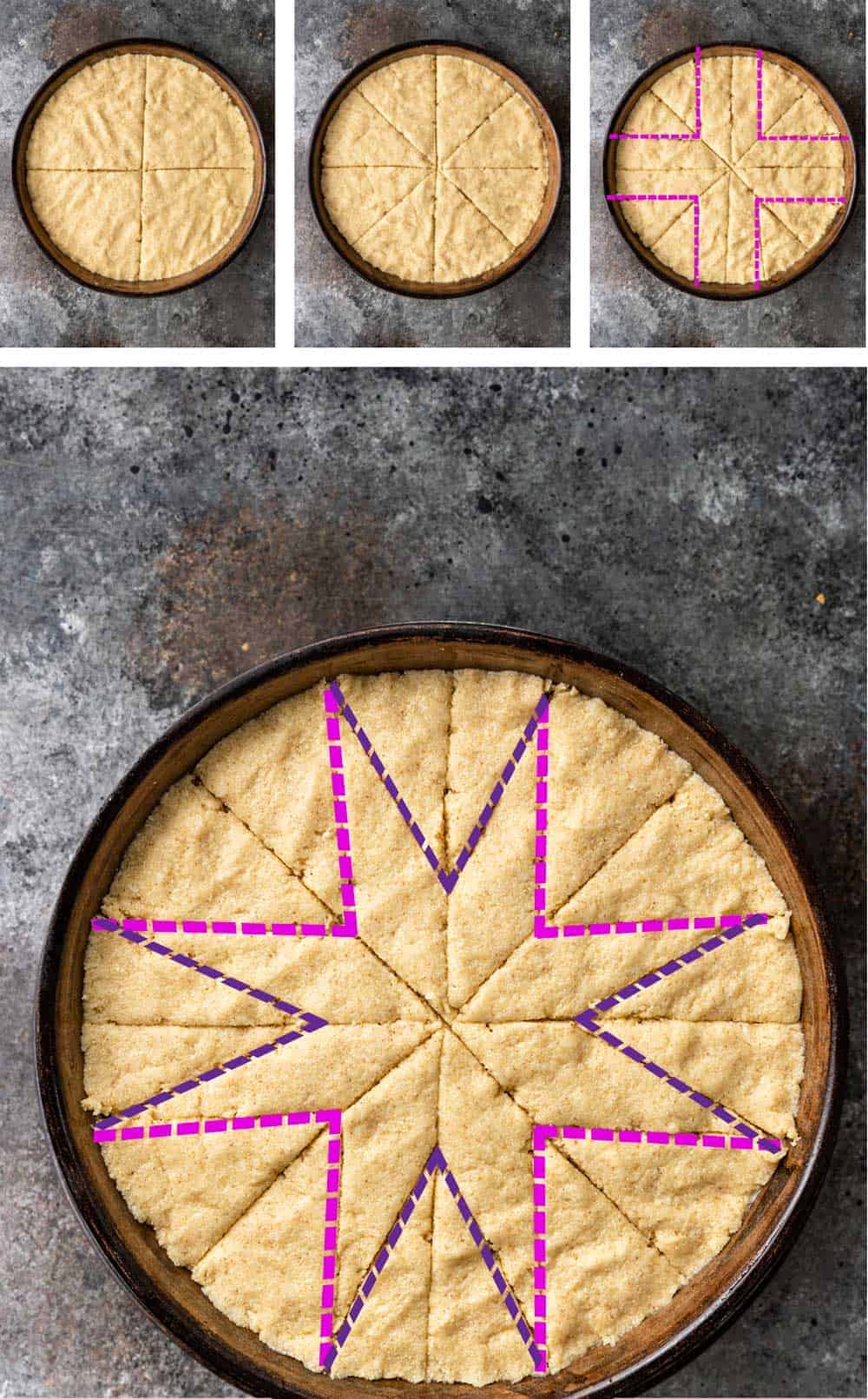
Nutrition
The information shown is an estimate provided by an online nutrition calculator. It should not be considered a substitute for a professional nutritionist’s advice.
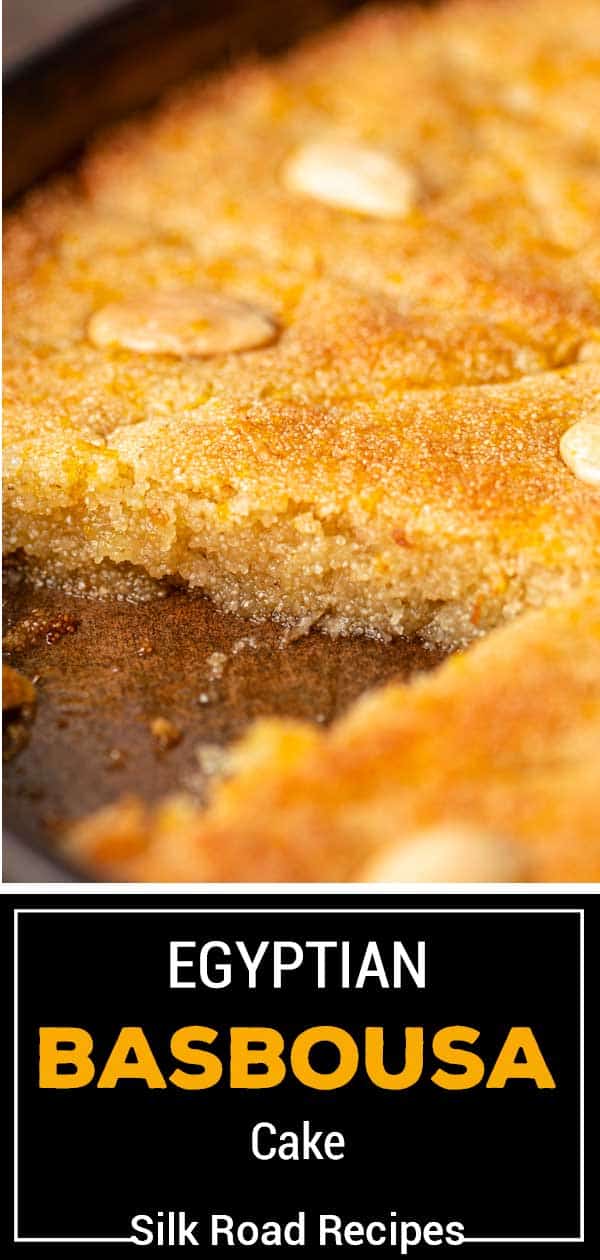

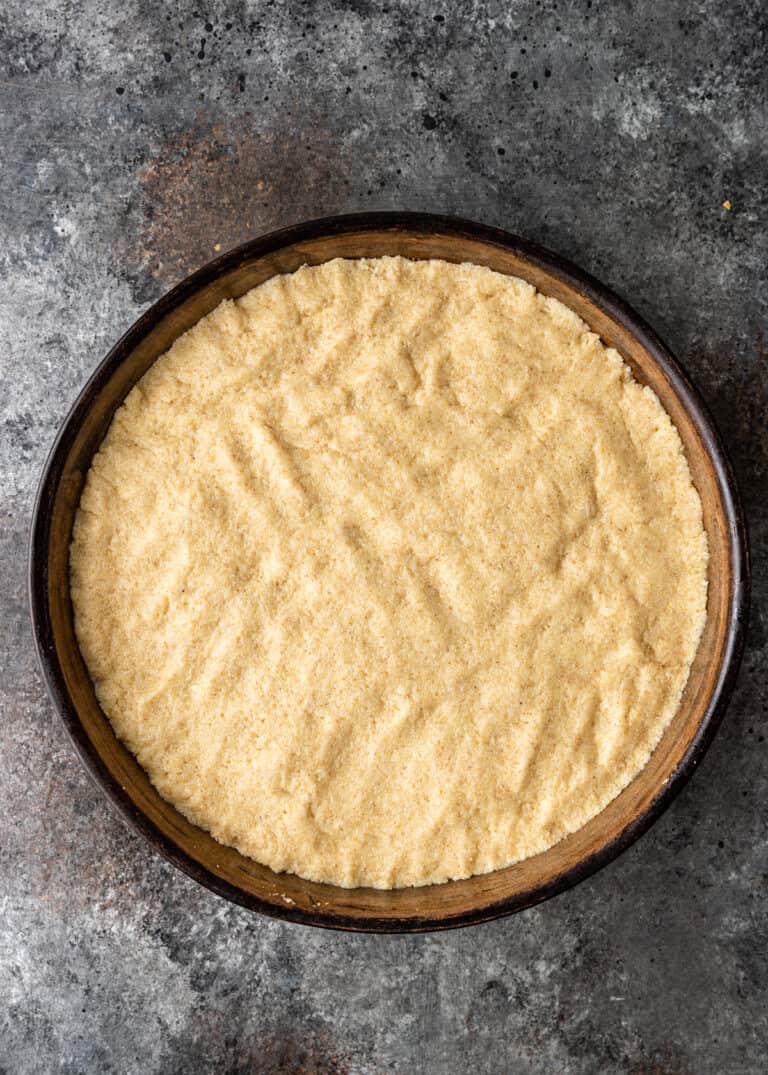
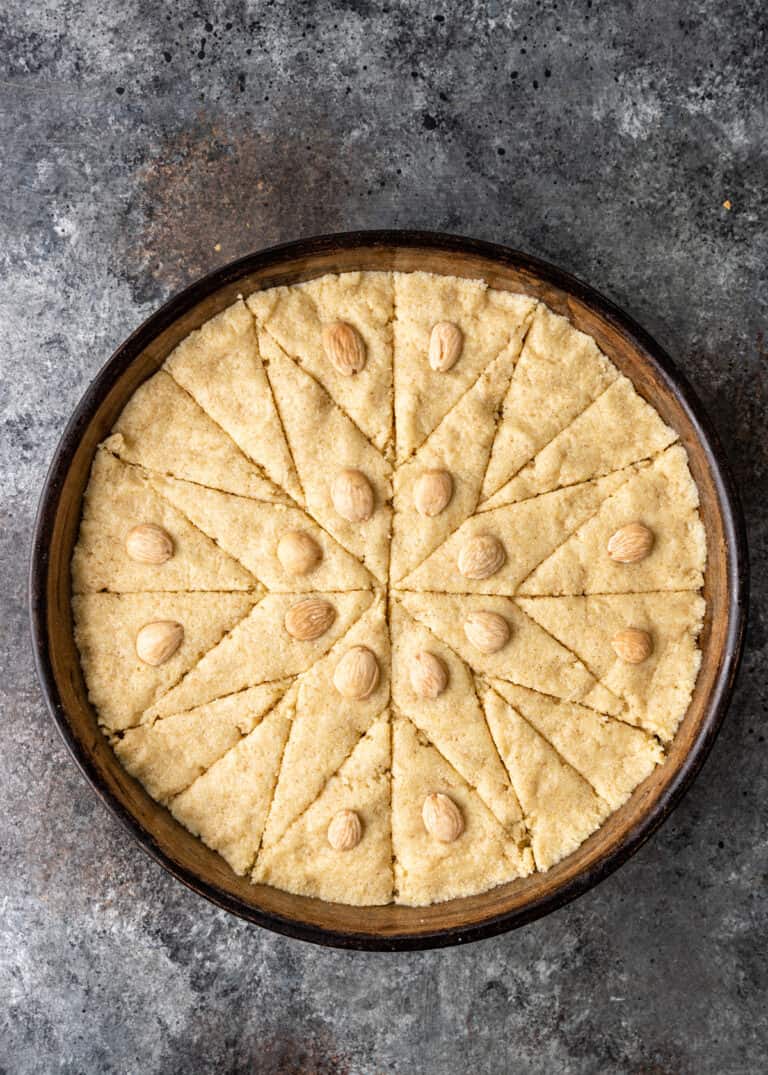

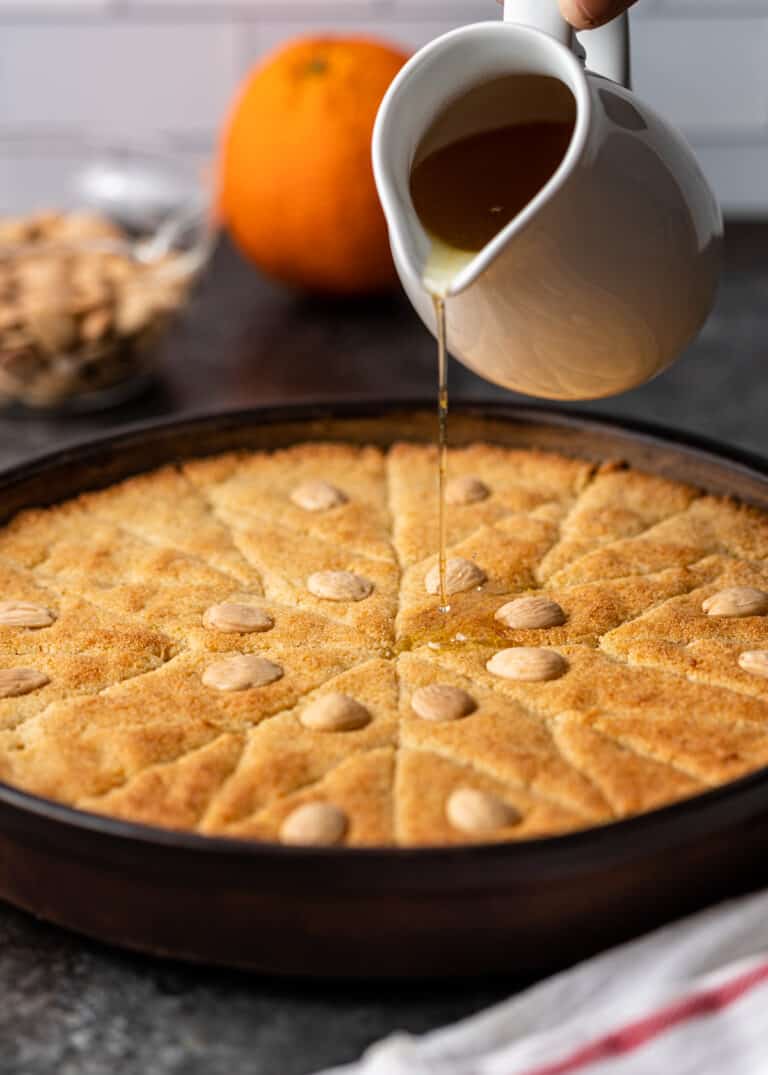



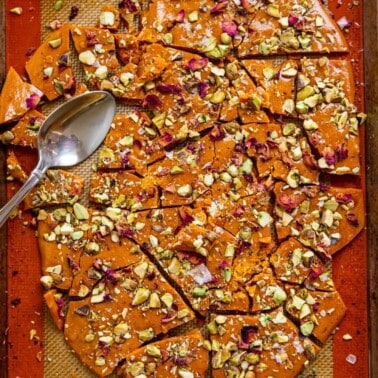
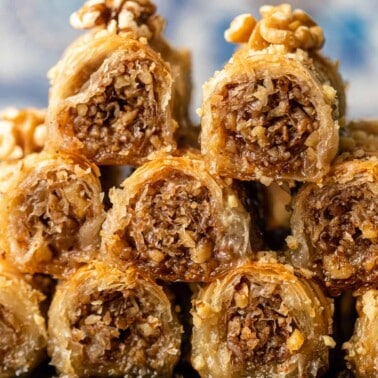
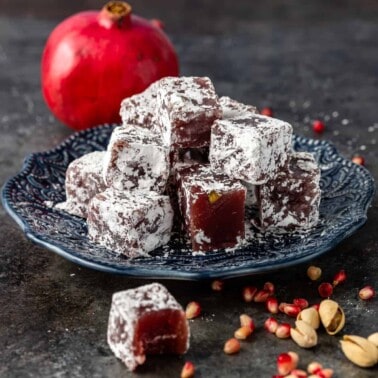
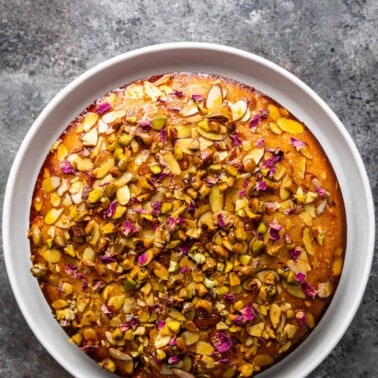








Can I make this a day ahead of serving it?
Also, if I use a 9″ round pan, will I need to adjust the cooking time? Thank you!
I would check it at the 20 minute mark and go from there Beth. I recently made one at a friends in an 8×8 and due to it being taller, baked longer.
excellent!
Thanks Miska!
Hi Kevin- If I were to omit the coconut, do I need to add any other ingredient to replace it? Thank you! I am so excited to make this!
Tien, if you choose not to add the coconut, simply omit, no replacement ingredient is needed. Enjoy!
I ate the first slice with a spoon
🙂
Just made it. Had one hot slice…gorgeous. But is it easy to get clean slices. I will wait for it to cool down before trying to lift the slices. I did the star cut as well.
Allow it to cool and then slice. Depends on how shallow a dish you you used to bake it in as well.
Thank you for the recipe.
I am not going to argue whether it should be ‘farina’, ‘flour’ instead of semolina. It says Cuisine: Egypt Assuming, Egyptians walk differently than Turks 😊 However, I prefer using Almond meal instead of semolina.
I realize this is a traditional Ottoman sweet cake that originated in Turkey and is made throughout the Middle East. This version is Egyptian. I received this recipe from a friend (a vendor’s mom from the Khan el-Khalili). The Khan el-Khalili is a famous bazaar and souq in Cairo and she used farina. Regardless it is a fantastic dessert. :).
will be making this soon can i use vegan butter and coconut yogurt as am dairy free i never had basbousa cake egyptian dessert before perfect for my birthday on 19 September and after office snacks sorry i took a break from commeting on your recipes as busy with work will dm you if i make this and let you know how it goes Thanks Ramya